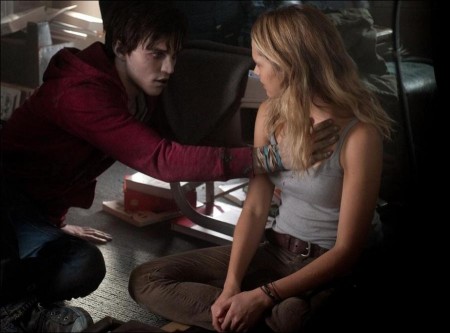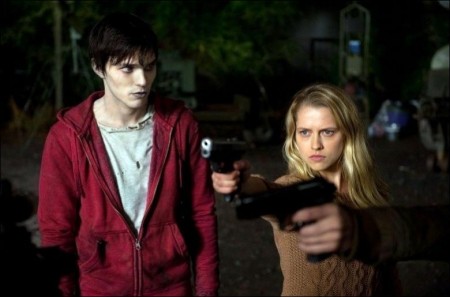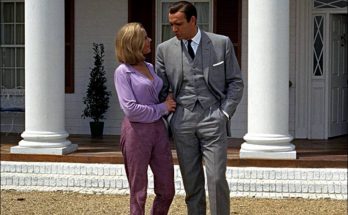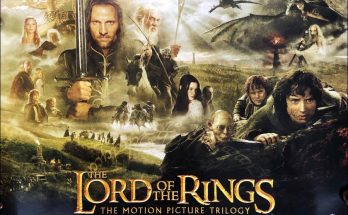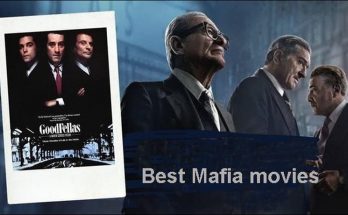Warm Bodies or zombie filled with love. An unlikely romance between a beautiful human teen and a sensitive undead slacker sets off a chain of events with the power to transform the world in Warm Bodies, the hilarious and heartwarming zombie action rom-com based on the popular novel by Isaac Marion.
It’s a familiar scenario — a mysterious virus has devastated civilization, turning its victims into flesh-eating monsters without memories of their past lives. What is left of humanity is holed up in heavily fortified bunkers where they live in fear of their former loved ones. But all that changes when a ravenous zombie hunting party crosses paths with a human reconnaissance crew scavenging supplies. R (Nicholas Hoult), a soulful zombie, is so captivated by the lovely and living Julie (Teresa Palmer) that, instead of eating her brains, he saves her from being consumed by his companions.
Taking her back to the zombie-ridden airport he calls home, R hides Julie in an abandoned 747 filled with treasures he has collected during his hunting expeditions — vinyl records, snow globes, musical instruments and other lost relics of a saner time. Over the next few days in their surprisingly cozy hideaway, the feisty Julie awakens long-forgotten feelings in R, while she begins to realize there is more to him than a vacant stare and a slow-motion shuffle.
Confused by her feelings, Julie returns to her walled-off city where her father (John Malkovich), a ruthless zombie hunter, leads a well-armed security force. Meanwhile, the lovelorn R has begun to change in ways he never thought possible and believes his connection with Julie could be the salvation of the human race. But when he shows up at her doorstep, it sparks an all‐out war between the living and the undead that threatens to derail the couple’s chance of a future together.
A fresh twist on a classic love story, Warm Bodies offers a surprisingly romantic look at the lighter side of the zombie apocalypse — and reminds us what it means to be human.
Warm Bodies began life as a seven‐page online short story titled “I am a Zombie Filled with Love” that attracted a wide Internet audience and led author Isaac Marion, with some encouragement, to expand it into his debut 2010 novel. Described as a “zombie romance” by the Seattle Post Intelligencer, complete with allusions to Shakespeare’s “Romeo and Juliet,” the novel captivated producer Bruna Papandrea (Milk, All Good Things).
“As a piece of writing, it was so elegant and beautiful,” says Papandrea, who at a friend’s recommendation got hold of the book before it was published and read it from cover to cover during a flight. “It had such an incredibly strong voice and character. Although it was a genre piece, it was an incredibly emotional, character-driven story.”
the filmmakers had to secure three main locations to shoot the film: the abandoned airport where R and the other zombies live; the walled-off Green Zone, where the General’s home is; and the Dead Zone outside the wall. Finding a location with an abandoned airport seemed like a tall order, but with the help of Summit’s head of physical production, Andi Isaacs, the filmmakers were able to get everything on their wish list in one city: Montreal.
Papandrea says the team could barely believe their good fortune in gaining access to an entire abandoned airport, which was called Mirabel. “Collectively, none of us had ever seen a location that gave this much value. It so perfectly fit the film we were making. It also has a very eerie, abandoned quality, which is great for the genre.”
There were some shooting restrictions, in that while Mirabel is no longer a commuter airport, it is still used by cargo planes. But aside from that, it was virtually abandoned roughly a half-dozen years ago-just as the fictional airport was in the film.
As to what they should call the airport, the filmmakers at one point decided on Barack Obama International Airport, and even began the process of clearing the name with the White House. But on second thoughts, they decided that name was too obvious and instead chose to call it Isaac Marion International Airport — “after our brilliant novelist,” Levine says.
The other two main locations were the Green Zone and the Dead Zone, which are separated by an immense wall built by General Grigio to keep zombies out of the humans’ space. Levine credits production designer Martin Whist (SUPER 8, CLOVERFIELD) with creating these two worlds in a way that made the film look like it had twice the budget that it did.
“The transition at the wall is strong,” says Whist. “Once we’re in the Green Zone, which was located in Old Montreal, things are cleaner and we have evidence of society trying to sustain itself. Inside the Green Zone it’s a quasi‐military state; they’re survivalists.”
There were also livestock in the Green Zone in the form of cows and goats — something that became quite a curiosity for the locals.
“These are the things and research that you have to do when you are creating a post-apocalyptic story,” explains executive producer Nicolas Stern. “How do these people survive? Where do they get their food, power and water? These are the things that Jonathan and the production designer thought about for months and months.”
Other key locations inside the Green Zone were the beautifully ornate Mount Stephen Club in downtown Montreal, some distance from Old Montreal, which stands in for General Grigio’s home; and a church that was actually an old monastery building located outside Montreal in the Laurentian Mountains.
“It’s an incredible location and was picked for the sheer architecture of the space,” explains Stern. “In this movie, we use a lot of big, wide-open spaces. We put small groups of people in them to really let you feel that there’s not that many people left in our world.”
For parts of the shoot, the filmmakers had to ask for whole sections of Montreal to be shut down — areas around the Old Port, in Old Montreal and in the financial district. “We’re talking long blocks, big vistas and cross sections of the community,” says Stern. “They were very helpful in doing that.”
For the Dead Zone, the dangerous area outside the wall where zombies roam free, Whist and his crew brought in plants and dirt to cover the ground, using them to visually show the passage of time as nature reclaimed the remains of civilization. But there are also signs of the civil unrest that erupted during the plague that destroyed civilization — specifically, socially conscious graffiti. Spray painting the walls of the heritage buildings that line the historic streets of Old Montreal was obviously not an option, so Whist and his crew coated the walls in a clear plastic material that hugged the contours of the stone when heated. “We then painted or printed our graffiti on it so it looks like the graffiti is on the stone,” explains Whist.
The team recruited graffiti artists from L.A. and Montreal to create this aspect of the post-apocalyptic world, and even approached renowned graphic designer Shepard Fairey about copying the style of one of his most famous works, “Andre the Giant Has a Posse.” Fairey obliged, and the team appropriated the image, replacing Andre the Giant with a Boney and the word “obey” with “pray.”
“To be able to use something that’s iconic, particularly in the world of street art, is fantastic,” says Whist. “It legitimizes and grounds our work in the real world. We created a whole library of street art and graffiti that I’ve been using from location to location.”
As for the wall itself, VFX supervisor Dan Schrecker (LIMITLESS, REQUIEM FOR A DREAM) and his crew used CG to make it longer and higher than was physically possible to build. Levine credits director of photography Javier Aguirresarobe, ASC (VICKY CRISTINA BARCELONA, THE ROAD, THE OTHERS) with helping to make WARM BODIES a visually stunning movie.
“Javier is a brilliant visual artist,” says the director. “The other great thing about Javier is that he has a lot of soul and heart and he connects to the soul and heart of the movie.” Aguirresarobe even managed to make the brain‐eating scenes visually appealing. “That’s a slightly violent moment in the film, where R is cracking Perry’s head open, but it’s shot very beautifully,” says Hoult. “The way Javier framed and lit everything, it just looks fantastic — even the more gruesome aspects, there’s still something very cinematic about them.”
Adding a surreal texture to the film are the numerous flashbacks R experiences as he eats the pieces of Perry’s brain he has hidden in his pocket.
“We’re often seeing things from Perry’s point of view or from behind Perry,” says second‐unit director Stephen Woolfenden (HARRY POTTER), who shot some of the flashback footage, often adhering to very specific pointers in Levine’s script about shooting into the sun in order to create flares for an abstract effect.
“We’ve tried to get as many lens flares as we could in this one,” Levine says. “I like the idea of kind of distorting the image. That’s something that lens flares can do beautifully.”
As part of the film’s visual palette, Aguirresarobe created a very specific look for scenes shot at night. “Our night look is fantastic,” says Levine. “He’s created a wonderful palette for it — a little blue, a little green. It’s very pretty. I love the flickering fluorescence of the airport, the darkness of the subway and the stadium, and all these giant abandoned locations that are lit in these very expressionistic ways that make sense because of the kind of world we’re in.”
Of course, a monster movie is only as good as its monsters. WARM BODIES’ most menacing creatures, the Boneys, were created using CG and stunt performers in motion-capture suits. Levine says using CG gave him a freedom he hadn’t experienced before.
“The great thing about CG is, not only can you create these characters, but you can do things stylistically that I feel like some people aren’t taking advantage of remotely enough. When we go into R’s dreams, for example, we do surreal transitions. At the very beginning of the movie, about the first 10 minutes, there’s a lot of really interesting, stylish CG that is used to tell the story in a way that people haven’t seen before. I’ve never had it as a tool in my arsenal before. It allows for the editorial process to be as creative as the production process.”
In creating the zombies, Levine says the team avoided an extremely gory look, drawing on things like Depression-era photos and images of coal miners instead of traditional zombie-movie references for inspiration.
“We wanted to make a movie that appealed to all ages, so we couldn’t necessarily get involved in some of the fun stuff that other zombie movies do,” Levine says, adding that the process of designing the looks of both the zombies and the Boneys was a lengthy one that started early in pre-production. “We had people doing sketches, artists taking a picture of Nick Hoult from SKINS or X-MEN, and tweaking and playing with it,” Levine says. “It would be back and forth internally, and then we would take it to the studio and do makeup tests.”
It was just one of numerous challenges the filmmakers had to overcome in the course of the production — not the least of them being the inclement Canadian weather. With shooting continuing well into November, some of the WARM BODIES actors ended up with decidedly cold bodies, particularly for scenes that were outdoors or in the unheated airport terminal. Palmer recalls one scene where some actors were driving a luggage cart.
“It was about zero degrees, we all had heat packs and were wearing a thousand layers,” the actress recalls. “Just before we shot, I asked Jonathan Levine, ‘What’s the temperature actually supposed to be in the film?’ He’s like, ‘It’s a balmy night. It’s warm.’ How were we going to pretend that? It was so cold that I couldn’t even get some of my words out.”
Even more extreme was the climactic fountain scene with Hoult and Palmer. The water started off hot but had turned freezing cold by the end of the day. “It’s such an imperative scene in the movie and there we are absolutely freezing cold,” Palmer recalls. “Our teeth were chattering, but it was really fun.”
And then there were the challenges stemming from the sheer physicality of the film’s fight scenes, which Palmer says she was not prepared for.
“When I first read the script, I was focused on the emotional depth of the film and the heavy dialogue scenes,” the actress says. “The second day that I was running around, because I hadn’t stretched, I was like someone with arthritis. I realized that I was just super unfit — it was quite embarrassing.”
Fortunately, it was Palmer’s second action film so she wasn’t a complete rookie, and had a good stunt crew to work with. “We didn’t really get a ton of time to rehearse specific moves,” Palmer says. “I would arrive on set and then have 20 minutes with the stunt team so they could quickly show me what to do. Thank God I had a little bit of martial arts training on my last film.” Gun training was also part of the job for several of the actors. “The first day I got to set, they had me and Dave Franco go to the gun range,” Tipton recalls. “We learned how to shoot every type of gun under the sun. It was terrifying, because I’m terrified of loud sounds, but it was also very freeing.”
Franco says his favorite scene is the one in the pharmacy where his character, Perry, meets his demise. He, however, is not in it. “My double was standing in for me and he gets pulled off the table,” says Franco. “He takes this brutal hit. So my favorite moment is someone else playing me in the movie!”
A major challenge for the makeup department was creating the right look for the zombies, which are referred to as corpses in the film. This was especially true for the character of R, who needed to be a somewhat sexy, good-looking zombie. Levine was keen to achieve these effects without prosthetics, using only makeup, and turned to head of makeup special effects Adrian Morot for the task.
Morot says R had to be somewhat attractive in order for it to be feasible that Julie would fall in love with him. “You can’t have teeth showing or a piece of flesh or ribcage; that’s really gross and a different kind of movie. The way I thought of him is that he needs to look a little like an undead James Dean.”
Related Link: View the Full Production Notes for Warm Bodies
Views: 86
